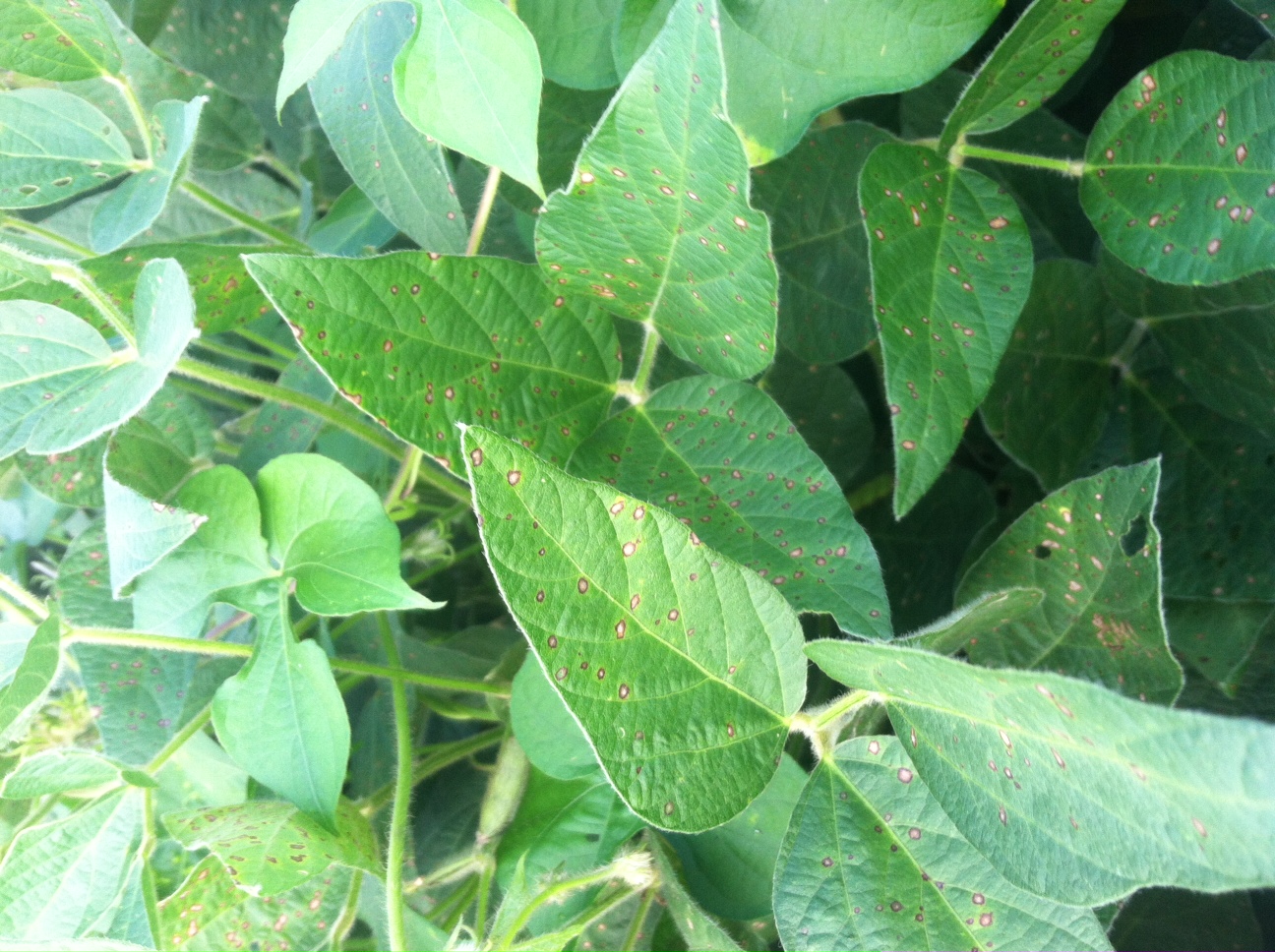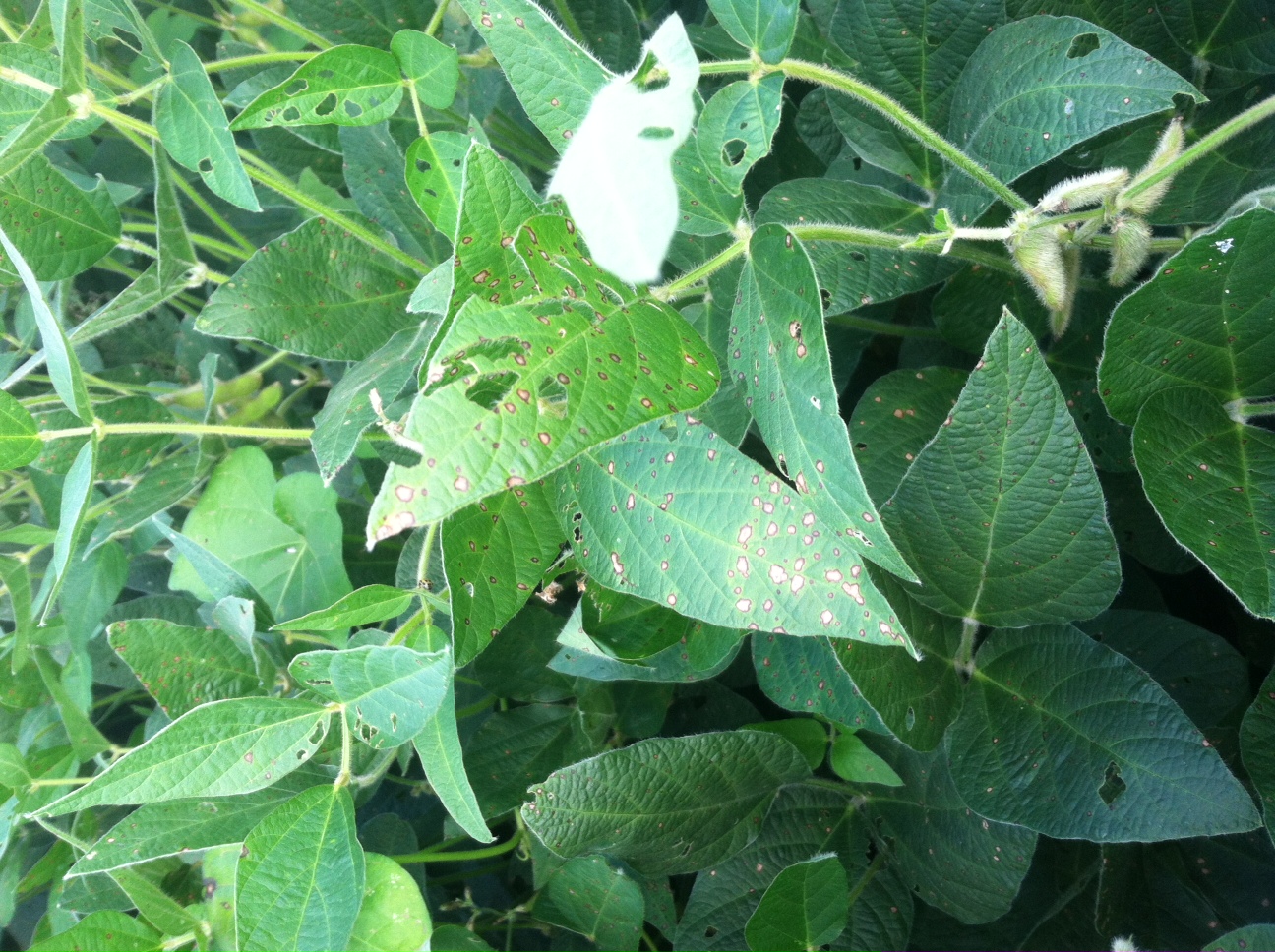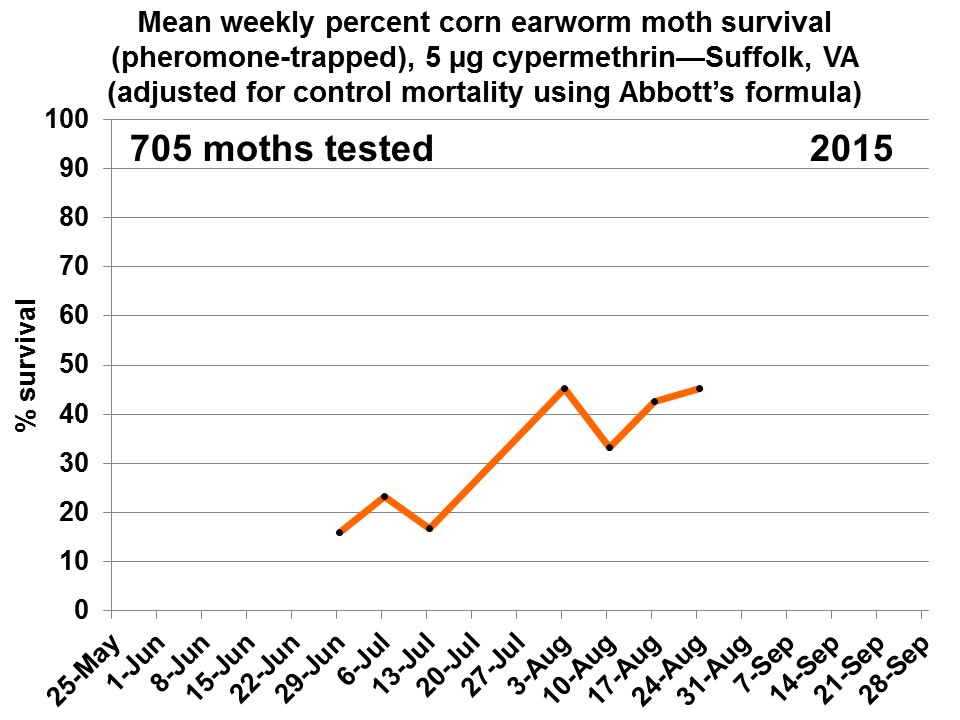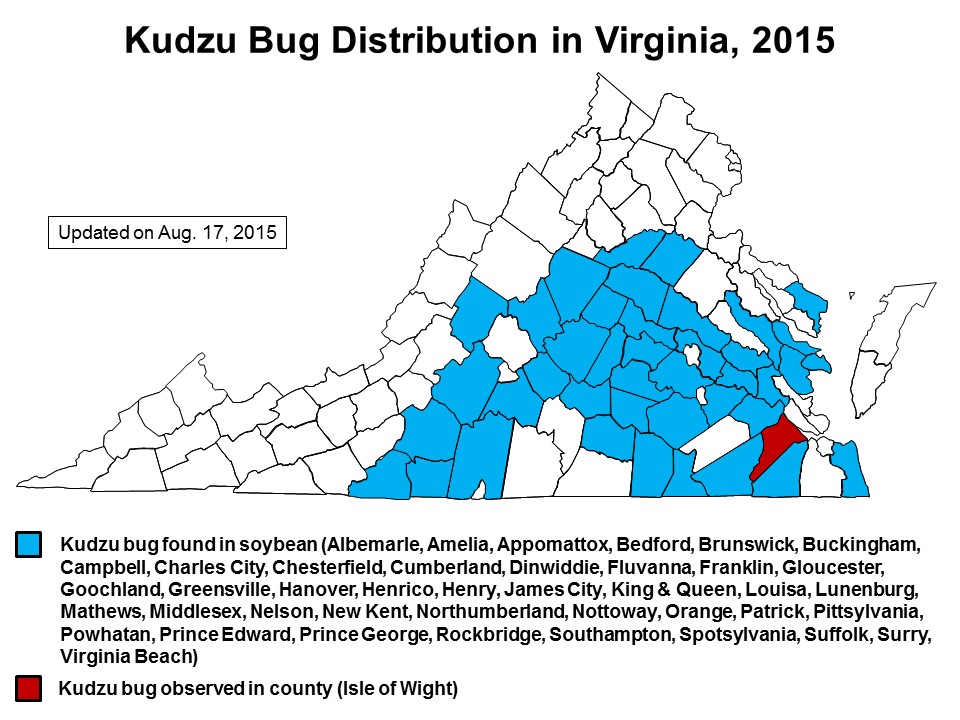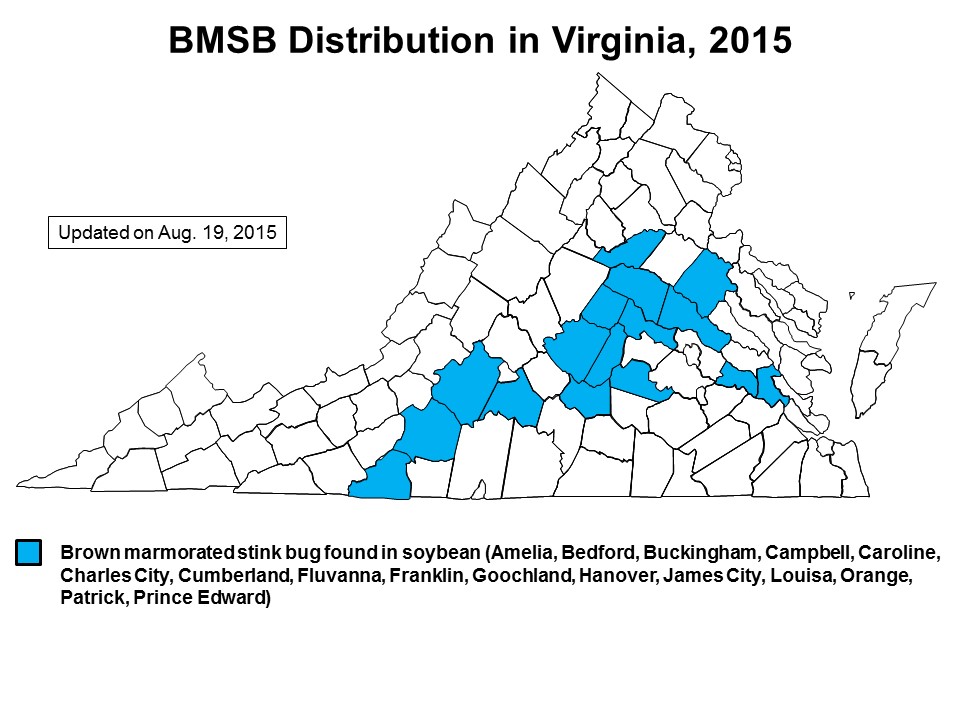So far this week we have tested 41 moths, with 37% surviving the 24-hour vial-test exposure to 5 micrograms of the pyrethroid insecticide, cypermethrin. This percentage falls very close to our seasonal average of 39% survival (n = 800 moths tested). The line graph, below, indicates our results to date. 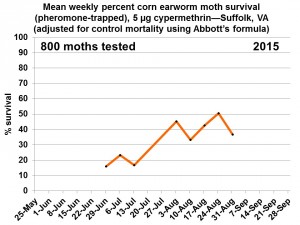
Category Archives: Pest Group
BMSB and kudzu bug distribution maps for the week ending August 27, 2015
Brown marmorated stink bug and kudzu bug were found in soybean in several additional Virginia counties this week–please refer to the distribution maps below. Fields at or above the BMSB threshold of 3 to 5 total adults + medium and large nymphs in a 2-minute visual count were found in the following counties: Bedford (12 BMSB per sample), Shenandoah (8 BMSB), Nelson (4 BMSB) and Henry (3 BMSB). Thanks to our scouts Ed Seymore and Jamie Hogue, and to ANR Agent Scott Reiter for their reports this week. 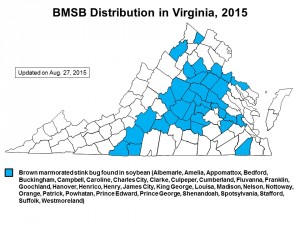
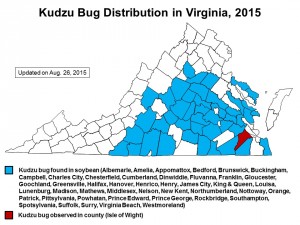
Soybean disease update – frogeye leaf spot
I have received numerous reports of soybean fields with moderate to severe frogeye leaf spot (FLS) over the past several weeks. In most cases, the disease is showing up in fields planted to a FLS susceptible variety and/or in fields that have been in continuous soybean. FLS can cause significant yield loss in susceptible varieties, so fungicides may be needed to control the disease in high risk fields (see accompanying blog post “Foliar fungicide applications in soybean”). Unfortunately, FLS isolates resistant to strobilurin (QoI, Group 11) fungicides have been confirmed from some locations in Virginia, so fungicide control failures can occur if the proper fungicide chemistries are not selected as illustrated in the pictures below. A soybean fungicide efficacy table with ratings based on data from multiple field trials in multiple states can be downloaded below. We are currently surveying fields in Virginia for strobilurin-resistant FLS and will have data on the frequency and distribution of resistance later this year. In the meantime, it should be assumed that FLS will not be controlled by strobilurin fungicides, and other fungicide chemistries (e.g. triazoles) should be applied in fields with FLS either alone or in combination with a strobilurin. Keep in mind that strobilurin fungicides still provide good control of other diseases that can occur in soybean.
Foliar fungicide applications in soybean
If and when to make a foliar fungicide application is a decision soybean producers must make each growing season. Every year is slightly different, and it is difficult to predict whether or not a fungicide application will be profitable. However, the risk factors listed below can be used to make an educated decision of whether or not to spray. The greater the number of risk factors in your field, the more likely it is that a fungicide application will be profitable.
- Growth stage of the crop. Disease is most likely to impact yield during pod and seed development since this is when the yield of the crop is being formed. Fungicides are more likely to result in a yield response if disease occurs between the beginning pod (R3) and full seed (R6) growth stages, a period that lasts approximately 30 days. Results from research conducted in 2014 suggest that a fungicide application is most likely to result in a yield response if weather conditions (see #2 below) conducive for disease development occur within two weeks of the R3/R4 growth stage. Overall, the optimum timing for a fungicide is at the R3/R4 growth stage, though later applications can be beneficial if diseases develop later in the season. Fungicide applications after the R5 growth stage are not recommended.
- Weather conditions. Currently, research is being conducted to develop a weather-based fungicide decision aid for soybean. Infection, growth, and sporulation by foliar pathogens occurs when temperatures are moderately warm and during periods of rainfall or high humidity. To determine the relative disease risk based on weather conditions, find a source of hourly temperature, rainfall, and relative humidity data (e.g. Weather Underground or a personal weather station). If over the past week the following conditions occurred on two or more days, the risk of disease development in the crop is high:
• Average daily temperatures from 65-80 °F AND
• 10 or more hours of relative humidity at or above 95% OR a rainfall event
These conditions have occurred in many areas throughout Virginia over the past week as storms have moved through. However, before making a fungicide application consider the other risk factors below. - Susceptibility of soybean variety to disease. Soybean varieties vary in their susceptibility to diseases, and more susceptible varieties are more likely to need a fungicide to protect yield. Keep in mind that a variety may be relatively resistant/tolerant to one or a few diseases but susceptible to others, so be aware of which diseases are most likely to occur in your field (see #4 and #5 below).
- Field history. Soybean debris is a source of pathogen inoculum, so diseases will show up earlier and be more severe in fields planted to soybean year after year compared to those in rotation with corn or another crop. History of a particular disease in a field should also be considered since it is likely to occur year after year.
- Confirmation of disease in a field. If you see a foliar disease starting to develop in your soybean crop, it may be a sign that it is time to apply a fungicide. Scouting may be useful for some diseases such as frogeye leaf spot, but other diseases (e.g. Cercospora blight) do not show symptoms until long after infections have occurred. Fungicides are more effective when applied preventatively, but applications shortly after the onset of symptoms will slow the progress of the disease. Thresholds have not been established for frogeye leaf spot or other foliar diseases of soybean.
- Yield potential. This year some soybean fields got off to a poor start and never really recovered. If growth is poor and yield potential is low, you do not have much yield to protect and fungicide applications are less likely to be profitable. In contrast, if a crop has high yield potential, a fungicide application can help to maximize that yield, especially if the variety is susceptible to disease.
Black light trap captures for the week ending August 20, 2015
Corn earworm moth nightly black light trap catches ranged from 0.1 to 12.1 per night–please see the attached data table for more information. No brown marmorated stink bugs were caught this past week in the black light traps. Thanks to all the Extension Agents for their reports this week. CEW_blt_Aug_20
Corn earworm advisory
The corn earworm moth flight is underway, but is still pretty light compared to past years. Worm numbers are gradually increasing in soybean, peanut, cotton, and sorghum fields, but are still not at economic levels.
Worms are rarely, if ever, an economic threat to peanuts as they feed only on leaves, feed for only a short time, and do not remove enough leaf area to result in any yield loss. So why do most peanut farmers spray their fields for worms when there is no chance that those sprays will improve the yields?
We are finding a few worms in soybean fields, but not many. And, if fields are not in the R5 growth stage (seed forming in the pods), worms are not a threat. They are only a threat when they start eating seed, so if no seed are present, there is no need to treat. If seed are present, a good rule-of-thumb threshold would be to treat if you catch an average of 1 to two per 15 sweeps—but only if seeds are present.
Most cotton, unless very late planted, is mature enough to be safe from worms. At this point in the season, it would be very hard to justify treating most cotton fields for worms.
Sorghum is a different story. Corn earworms are highly attracted to sorghum heads, especially late planted sorghum. For more information on this, read to sorghum insect pest advisory that was just posted.
We are detecting a pretty high level of pyrethroid resistance in the corn earworm moths we are testing. The attached figures show this. With 705 moths tested so far this year, we are seeing an increase in the number surviving with a cumulative average of 37.5 percent survival. From the attached figure, you can see that this is high compared to previous years. Non-pyrethroid insecticides will need to be considered, especially if heavy infestations occur.
Kudzu bug distribution map update for August 19, 2015
Brown marmorated stink bug distribution map update for August 19, 2015
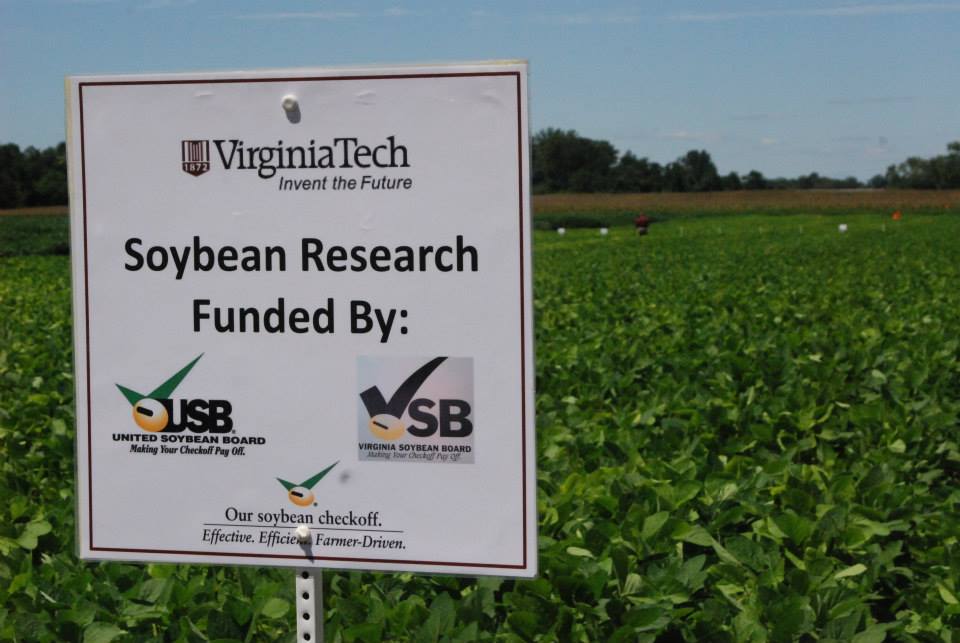
The Virginia Soybean Field Day is this Thursday
VIRGINIA SOYBEAN FIELD DAY
Thursday August 20, 2015
Eastern Virginia Agricultural Research & Extension Center
2229 Menokin Road
Warsaw, VA 22572
(804) 333-3485
Sponsored by
Virginia Soybean Association
Virginia Agricultural Experiment Station
Virginia Cooperative Extension
Join us to see the latest research on soybean varieties, disease and weed management, IPM and sorghum varieties. Experts will also demonstrate no-till drill maintenance and update you on the mid-Atlantic double crop initiative. Registration begins at 8:00 am and field tours begin at 8:50 am. The program will end at noon with a delicious meal by Nixon Catering.
Topics include:
– Soybean Disease Management – Dr. Hillary Mehl
– Soybean Weed Management – Dr. Mike Flessner
– Soybean Insect IPM – Mr. Mike Parish and Drs. Sean Malone and Ames Herbert
– No-Till Drill Maintenance – Mr. Keith Burgess
– Grain Sorghum Management – Dr. Joseph Oakes
– Roundup-Ready Public Soybean Varieties – Dr. Bo Zhang
– Mid-Atlantic Double-Crop Soybean Initiative – Dr. David Holshouser
We hope to see you there!
Black light trap catches for the week ending August 6, 2015
Corn earworm moth captures started increasing in area black light traps, ranging from 0.3 to 7.5 per night. Brown marmorated stink bug nightly averages ranged from zero to 12.9. Please see the data tables for specifics. Thanks to the following for their reports this week: John Allison, Scott Reiter, David Moore, Mary Beahm, Austin Brown, Janet Spencer, Keith Balderson, and Ames Herbert and his entomology crew. BLT_Aug_6

